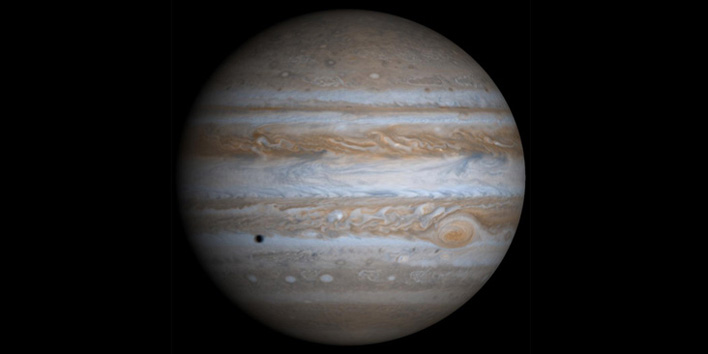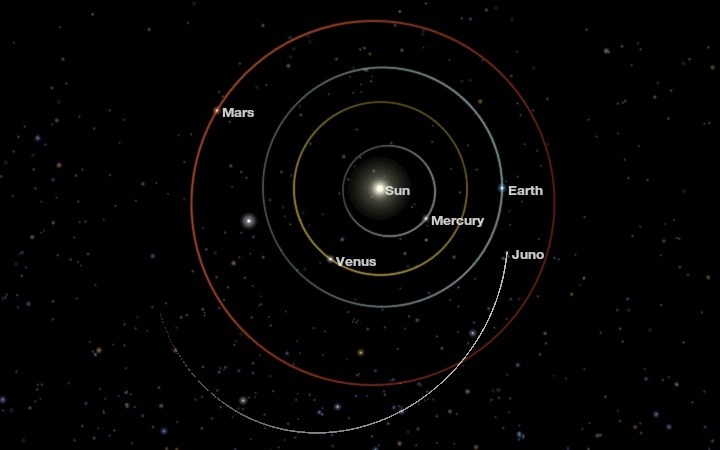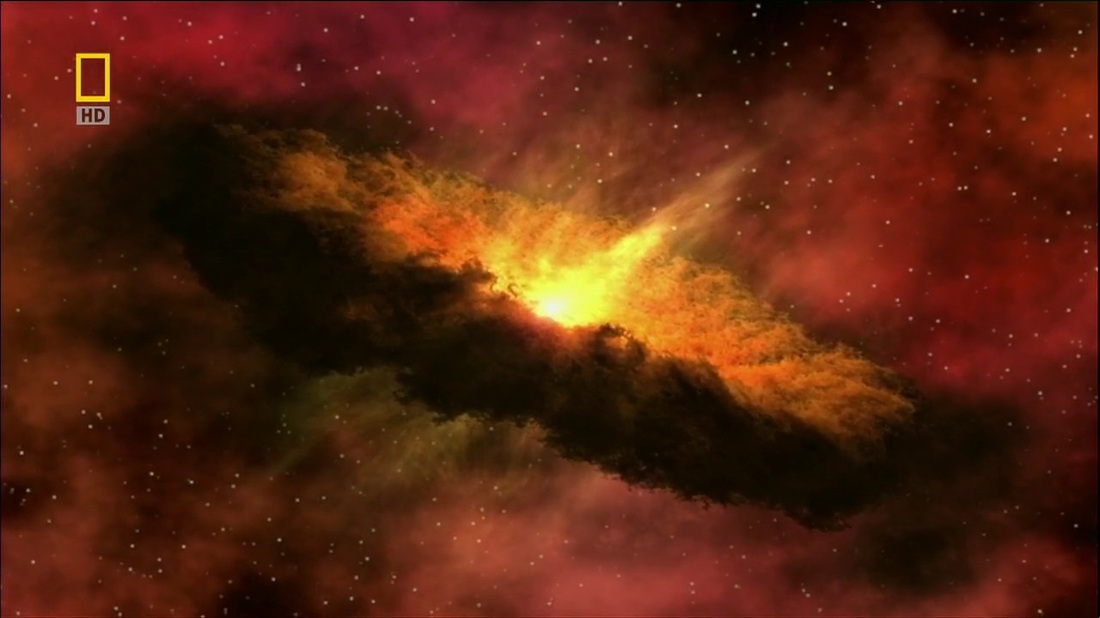True Color picture of Jupiter taken by the Cassini Spacecraft on its way to the planet Saturn
Goldilocks Universe – 5A Jupiter & Juno August 10, 2013
On August 5, 2011 on top of an Atlas 5 rocket NASA launched a Spacecraft named Juno on its 483 million mile journey to Jupiter. On October 9, 2013 Juno returned to earth after traveling 298 million miles in two years (over half the distance). What Happen?
To understand what is going on we need to know that Juno is a 4 ton Spacecraft that needs to travel 483 million miles from Earth to Jupiter.
Following launch, the Atlas V rocket accelerated the Juno Spacecraft to 25,000 miles per hour in order to break away and escape from the Earth’s Gravity. Once the Atlas V rocket fuel was exhausted, the Earth’s gravity would start to slow down Juno’s velocity from 25,000 miles per hour to a much slower speed until Juno’s distance from the Earth was so far that it was beyond Earth's gravitational influence.
But now the Sun’s gravity took over and continued to slow Juno’s
velocity to a crawl. By this time Juno was in the vicinity of the Asteroid
belt about 298 million miles from Earth. Because of the Sun's strong gravity, Juno started to fall toward the Sun. As Juno was hurling towards the Sun, it speed increased to 78,000 miles per hour.
This was not a un-control plunge, but a planned trajectory to fly near the Earth at a distance as close as 350 miles. Once in the Earth vicinity, the Earth’s
gravity was stronger than the Sun’s gravity, and it swung Juno ("Gravity Assist") around the earth and back on the path towards Jupiter at a new
velocity of 87,000 miles per hour or 25 miles per second.
The smart people at NASA have been using “Gravity Assist” trajectories of
Earth and other planets to booster the velocity of large Spacecraft on trips to
Mars, Jupiter and beyond. We cannot afford to build a rocket that can accelerate a 4 ton vehicle to 87,000 miles per hour and that’s the reason NASA uses Gravity Assist on long distance journeys. Juno will arrive at Jupiter on July 4, 2016.
Pioneer, Voyager, Galileo, Ulysses, Cassini, and New Horizons Spacecraft have visited (some for Gravity Assist) or studied our planet Jupiter. So why is NASA embarking on the Juno mission? The answer is very simple. Every time we explore, discover, and learn new stuff about ourselves and our universe we end up with more questions and mysteries that need to be answered and solved. Juno will verify more precisely some of the knowledge we already possess and shed light on some of the new mysteries.
Our current understanding is that Jupiter was the first planet formed right after the birth of our Sun. Juno will try to pinpoint more accurately the time of Jupiter’s birth. Previous Goldilocks Universe articles highlighted the importance of Jupiter to the formation of our Earth. But Jupiter did more. It orchestrated the formation (orbits & contents) of our entire solar system: the planets, asteroids, and comets. Very important for us is that Jupiter prevented our young Sun from absorbing or expelling all the materials needed for life on Earth.
Following launch, the Atlas V rocket accelerated the Juno Spacecraft to 25,000 miles per hour in order to break away and escape from the Earth’s Gravity. Once the Atlas V rocket fuel was exhausted, the Earth’s gravity would start to slow down Juno’s velocity from 25,000 miles per hour to a much slower speed until Juno’s distance from the Earth was so far that it was beyond Earth's gravitational influence.
But now the Sun’s gravity took over and continued to slow Juno’s
velocity to a crawl. By this time Juno was in the vicinity of the Asteroid
belt about 298 million miles from Earth. Because of the Sun's strong gravity, Juno started to fall toward the Sun. As Juno was hurling towards the Sun, it speed increased to 78,000 miles per hour.
This was not a un-control plunge, but a planned trajectory to fly near the Earth at a distance as close as 350 miles. Once in the Earth vicinity, the Earth’s
gravity was stronger than the Sun’s gravity, and it swung Juno ("Gravity Assist") around the earth and back on the path towards Jupiter at a new
velocity of 87,000 miles per hour or 25 miles per second.
The smart people at NASA have been using “Gravity Assist” trajectories of
Earth and other planets to booster the velocity of large Spacecraft on trips to
Mars, Jupiter and beyond. We cannot afford to build a rocket that can accelerate a 4 ton vehicle to 87,000 miles per hour and that’s the reason NASA uses Gravity Assist on long distance journeys. Juno will arrive at Jupiter on July 4, 2016.
Pioneer, Voyager, Galileo, Ulysses, Cassini, and New Horizons Spacecraft have visited (some for Gravity Assist) or studied our planet Jupiter. So why is NASA embarking on the Juno mission? The answer is very simple. Every time we explore, discover, and learn new stuff about ourselves and our universe we end up with more questions and mysteries that need to be answered and solved. Juno will verify more precisely some of the knowledge we already possess and shed light on some of the new mysteries.
Our current understanding is that Jupiter was the first planet formed right after the birth of our Sun. Juno will try to pinpoint more accurately the time of Jupiter’s birth. Previous Goldilocks Universe articles highlighted the importance of Jupiter to the formation of our Earth. But Jupiter did more. It orchestrated the formation (orbits & contents) of our entire solar system: the planets, asteroids, and comets. Very important for us is that Jupiter prevented our young Sun from absorbing or expelling all the materials needed for life on Earth.
Picture of Juno Spacecraft:
www.explore-universe.weebly.com (click tab: Juno)
Juno will examine more closely the atmosphere and the interior contents of Jupiter to determine how it developed and shaped our solar system. One of the current theories is that the core of Jupiter is made up of a rocky planet the size of Earth. Also because Jupiter contains more carbon, nitrogen, and oxygen than the Sun it’s believed that Jupiter with the help of Saturn, Neptune, and Uranus, via gravity transported water (comets) heavy elements like oxygen, carbon, iron …, from interstellar space to Earth and the other planets in our solar system. Without those elements there would be no life on Earth.
As we search the heavens we are discovering many planets the size of Jupiter. Because these large planets determine the fate of their solar system, it is very important to understand our Jupiter's evolution and development. As we search for the possibility of life in other solar system, we need to start by exploring their large Jupiter size planets.
Our current knowledge of Jupiter’s composition:
Atmosphere: Hydrogen and Helium gas
Outer Layer: Liquid Hydrogen and Helium
Inner Layer: Liquid Metallic Hydrogen
Core: Rock, Metal and Hydrogen compounds
Diameter: 88,846 miles at the equator (Earth = 7,926 miles)
Birth of Our Solar System
www.explore-universe.weebly.com (click tab: Juno)
Juno will examine more closely the atmosphere and the interior contents of Jupiter to determine how it developed and shaped our solar system. One of the current theories is that the core of Jupiter is made up of a rocky planet the size of Earth. Also because Jupiter contains more carbon, nitrogen, and oxygen than the Sun it’s believed that Jupiter with the help of Saturn, Neptune, and Uranus, via gravity transported water (comets) heavy elements like oxygen, carbon, iron …, from interstellar space to Earth and the other planets in our solar system. Without those elements there would be no life on Earth.
As we search the heavens we are discovering many planets the size of Jupiter. Because these large planets determine the fate of their solar system, it is very important to understand our Jupiter's evolution and development. As we search for the possibility of life in other solar system, we need to start by exploring their large Jupiter size planets.
Our current knowledge of Jupiter’s composition:
Atmosphere: Hydrogen and Helium gas
Outer Layer: Liquid Hydrogen and Helium
Inner Layer: Liquid Metallic Hydrogen
Core: Rock, Metal and Hydrogen compounds
Diameter: 88,846 miles at the equator (Earth = 7,926 miles)
Birth of Our Solar System
Goldilocks Universe – 5, Updated September 23, 2013
Jupiter played a major role in the formation and evolution of Earth and the other Planets in our Solar System. Juno will arrive at Jupiter on July 4, 2016 and begin an important mission that will add to our knowledge and understanding of this amazing planet.
A summary of our current knowledge of Jupiter is as follows:
1) Shortly after the birth of our Sun, one of the first planets to come on the scene was Jupiter. This planet was formed from the hydrogen and Helium Gas, Asteroids, dust, and Heavy elements (iron, oxygen, carbon, sulfur, nitrogen…..). Jupiter holds the key to Earth’s formation.
2) Jupiter’s gravity became a counter balance to the Sun, preventing our Star from absorbing all the gas, rocks and Heavy Elements in the swirling whirlpool. The leftover stuff enabled the Earth and the other planets to form.
3) As the solar system disc debris kept rotating in circular motion around our Sun, Jupiter and the other giant planets prevent the important materials (carbon, nitrogen, oxygen…) needed for Earth’s evolution from being tossed out of the earth’s vicinity.
4) Earth, Mercury, Venus, and Mars were formed by Asteroids, dust… aggregating to create the inner solar system rocky planets as they circled the Sun at relatively slow velocities. Jupiter intervened to stop Earth’s planet growth by changing the circular orbits of Asteroids to high velocity elliptical orbits, thereby stopping planet aggregation. The Asteroids would now crash into each other instead of fusing together to build larger planets.
5) Jupiter cleaned up the debris and most Asteroids that could pose a danger to earth.
6) Jupiter along with other outer planets protects Earth from most comets and rocks that originate in the Oort cloud and Kuiper Belt.
Jupiter played a major role in the formation and evolution of Earth and the other Planets in our Solar System. Juno will arrive at Jupiter on July 4, 2016 and begin an important mission that will add to our knowledge and understanding of this amazing planet.
A summary of our current knowledge of Jupiter is as follows:
1) Shortly after the birth of our Sun, one of the first planets to come on the scene was Jupiter. This planet was formed from the hydrogen and Helium Gas, Asteroids, dust, and Heavy elements (iron, oxygen, carbon, sulfur, nitrogen…..). Jupiter holds the key to Earth’s formation.
2) Jupiter’s gravity became a counter balance to the Sun, preventing our Star from absorbing all the gas, rocks and Heavy Elements in the swirling whirlpool. The leftover stuff enabled the Earth and the other planets to form.
3) As the solar system disc debris kept rotating in circular motion around our Sun, Jupiter and the other giant planets prevent the important materials (carbon, nitrogen, oxygen…) needed for Earth’s evolution from being tossed out of the earth’s vicinity.
4) Earth, Mercury, Venus, and Mars were formed by Asteroids, dust… aggregating to create the inner solar system rocky planets as they circled the Sun at relatively slow velocities. Jupiter intervened to stop Earth’s planet growth by changing the circular orbits of Asteroids to high velocity elliptical orbits, thereby stopping planet aggregation. The Asteroids would now crash into each other instead of fusing together to build larger planets.
5) Jupiter cleaned up the debris and most Asteroids that could pose a danger to earth.
6) Jupiter along with other outer planets protects Earth from most comets and rocks that originate in the Oort cloud and Kuiper Belt.



